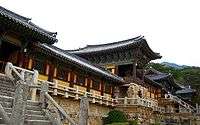Korean emperor
Korean emperors were monarchs in the history of Korea who used the title of emperor or an equivalent.
Part of a series on the |
||||||||
|---|---|---|---|---|---|---|---|---|
| History of Korea | ||||||||
 | ||||||||
| Prehistoric period | ||||||||
| Ancient period | ||||||||
|
||||||||
| Proto–Three Kingdoms period | ||||||||
| Three Kingdoms period | ||||||||
|
||||||||
| Northern and Southern States period | ||||||||
|
||||||||
| Later Three Kingdoms period | ||||||||
|
||||||||
| Dynastic period | ||||||||
|
||||||||
| Colonial period | ||||||||
|
||||||||
| Modern period | ||||||||
|
||||||||
| Topics | ||||||||
| Timeline | ||||||||
History
Three Kingdoms of Korea
Based on epitaphs dating to the 4th and 5th centuries, Goguryeo had concepts of Son of Heaven (天帝之子) and independent tianxia.[1][2][3] Some rulers of Goguryeo, such as Gwanggaeto the Great and Jangsu, used the title of Taewang (태왕; 太王; lit. "Greatest King"), which was equivalent to "emperor" and indicated an independent worldview.[4] Some rulers of Silla, such as Beopheung and Jinheung, also used the title of Taewang.[5]
Balhae
The rulers of Balhae used imperial titles, such as Seongwang (성왕; 聖王; lit. "Holy King") and Hwangsang (황상; 皇上; lit. "Emperor"), and had independent era names.[6][7]
Goryeo
The rulers of Goryeo used the titles of emperor and Son of Heaven and positioned Goryeo at the center of the Haedong "East of the Sea" tianxia, which encompassed the historical domain of the "Samhan", another name for the Three Kingdoms of Korea.[8] Imperial titles were used since the founding of Goryeo, and the last king of Silla addressed Wang Geon as the Son of Heaven when he capitulated.[9] In 1270, Goryeo capitulated to the Mongols and became a semi-autonomous "son-in-law state" (부마국; 駙馬國) of the Yuan dynasty, bringing an end to its imperial system.[8]
Korean Empire
References
- Yeongkwang, Jo (2015). "Status and Tasks for Study of the Foreign Relations and World View of Koguryo in the Gwanggaeto Stele". Dongbuga Yeoksa Nonchong (in Korean) (49): 70–76. ISSN 1975-7840. Retrieved 3 November 2018.
- "고구려의 천하관". 우리역사넷 (in Korean). National Institute of Korean History. Retrieved 3 November 2018.
- "장수왕의 남진 정책". 우리역사넷. National Institute of Korean History. Retrieved 6 December 2018.
- "Goguryeo's Worldview and Three Kingdoms". Korea Now. Korea Herald. 33: 32. 2004. Retrieved 19 February 2019.
They called their king "taewang" ("the greatest king"). Taewang was a title equivalent to "emperor" and referred to the ruler of the entire world of Goguryeo. In short, the practice of calling their king "taewang" was based on Goguryeo's independent worldview.
- "(1) 대왕호의 사용과 연호의 제정". 우리역사넷. National Institute of Korean History. Retrieved 13 January 2019.
- "발해(渤海)". Encyclopedia of Korean Culture. Academy of Korean Studies. Retrieved 19 February 2019.
- Kim, Jinwung (2012). A History of Korea: From "Land of the Morning Calm" to States in Conflict. Indiana University Press. p. 88. ISBN 9780253000248. Retrieved 19 February 2019.
- Em, Henry (2013). The Great Enterprise: Sovereignty and Historiography in Modern Korea. Duke University Press. pp. 24–26. ISBN 0822353725. Retrieved 3 November 2018.
- 이윤섭 (2012). "고려의 천하관". 역동적 고려사 (in Korean). 필맥. ISBN 9788997751006. Retrieved 3 November 2018.